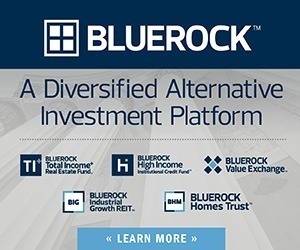The Interesting Case of Highlands REIT-Part I in a series on InvenTrust Properties Corporation
March 27, 2018 | James Sprow | Blue Vault

Highlands REIT, Inc. was created to own and manage substantially all of the “non-core” assets previously owned and managed by InvenTrust Properties Corp. InvenTrust is a nontraded REIT that was originally incorporated as Inland American Real Estate Trust, Inc. and raised over $8.3 billion in its public offerings which closed in 2009, making it the largest nontraded REIT in history in AUM. Near its peak in 2010, the REIT reported net property investment of $9.3 billion in 881 properties, excluding its lodging and development properties, located in 35 states.
In 2012, Inland American began implementing a strategy of focusing its diverse portfolio of real estate into three asset classes – retail, lodging and student housing. The goal was to position the company to explore various strategic transactions and liquidity for its shareholders. In 2014 the REIT became self-managed and became independent of its previous sponsor, The Inland Group, Inc.
When a huge, diversified REIT such as InvenTrust positions itself for a full-cycle event, the options are limited. Due to its size and diversity, potential merger partners such as large listed REITs are fewer than those that could be interested in a smaller, better defined portfolio. Listing a diversified REIT can also be problematic, as the market may not value the diverse portfolio favorably in the eyes of its management due to the rather unique combination of different asset types. Markets tend to understand and value homogeneous portfolios and businesses more accurately because there are apples-to-apples comparisons available. Conversely, markets may discount the values of portfolios that are too diverse or require too much asset-by-asset research to understand.
In a way, Inland American Real Estate Trust’s very success at raising capital and its diversification into so many different asset types may have become a handicap as it transitioned to self-management and re-branded to InvenTrust Properties Corp. Its sheer size made pursuing a full-cycle event more complicated.
In May 2014 the REIT sold 294 retail, office and industrial properties for a total of approximately $2.6 billion. In November 2014 it sold a portfolio of 52 select service hotels for approximately $1.1 billion. Then, in February 2015 it spun-off a subsidiary, Xenia Hotels & Resorts, Inc. which at the time owned 46 premium full-service hotels and two hotels in development, giving each holder of Inland American’s common stock 1/8th of a share of Xenia’s common stock. On February 4, 2015, Xenia’s common stock began trading on the NYSE under the ticker symbol “XHR.”
In April 2015 Inland American Real Estate Trust, Inc. changed its name to InvenTrust Properties Corp.
On April 26, 2016, InvenTrust Properties Corp. completed the spin-off of Highlands REIT, Inc. Later, in June 2016 it sold its student housing platform, University House Communities Group. By December 2017 InvenTrust was no longer a diversified portfolio but was focused on being a multi-tenant retail platform.
Highlands REIT, Inc. began its life as a portfolio of those assets that InvenTrust considered “non-core” and included assets that are special-use, single-tenant or build-to-suit, face unresolved legal issues, are in undesirable locations or in weak markets or submarkets, are aging or functionally obsolete, and have suboptimal leasing metrics.
To quote the Highlands REIT 2016 10-K,
Assets with such characteristics are relatively illiquid compared to other types of real estate assets and may require additional investments to improve our disposition options. In addition, certain of these assets are in hyper-amortization under their loan agreements (resulting in rental payments less certain expenses being used to pay down the principal amount of the loan); have rental payments, less certain expenses, being “swept” and held by the lender pursuant to the loan agreement; and are in or likely to enter foreclosure proceedings. These factors may also limit our disposition options with respect to these properties and has had, and is expected to continue to have, an adverse impact on the cash flow generated by such assets. For example, three of our assets, contributing $47.93 million (or 54.1%) in annualized base rent for the year ended December 31, 2015, prior to the Distribution, are now either in foreclosure or are likely to enter into foreclosure proceedings in 2017.
In other words, Highlands REIT started life as a collection of, shall we say, junk.
In the 2016 10-K, the REIT stated: “The aggregate market value of the registrant’s common stock held by non-affiliates of the registrant as of June 30, 2016 (the last business day of the registrant’s most recently completed second quarter) was approximately $310.3 million, based on the estimated per share value of $0.36 as established by the registrant on April 28, 2016.“
In May 2017 MacKenzie Capital Management made a third-party tender offer for up to 45,000,000 shares of Highlands REIT for $0.17 per share. The offer closed In June 2017 after receiving approximately 6,600,000 shares, after which MacKenzie would own approximately 9,537,000 shares or approximately 1.1% of the total outstanding shares.
In 2017, Highlands disposed of several properties via sheriff’s sales, paid off debt, sold several land parcels and a multi-tenant office asset, and actually acquired two multi-family assets. As of December 31, 2017, its portfolio consisted of two office assets, two industrial assets, six retail assets, two multi-family assets, two correctional facilities, two parcels of unimproved land and one bank branch.
As of December 31, 2017, the book value of stockholders’ equity was $0.297 per share. On January 5, 2018, the REIT announced an estimated value of its common stock as of December 31, 2017 equal to $0.33 per share on a fully diluted basis. Largely due to a $194.6 million gain on extinguishment of debt, the 2017 income statement showed net income of $0.20 per share, following a $0.07 per share loss in 2016 and $0.02 profit in 2015. Of course, GAAP-based income numbers don’t necessarily reflect market values. Looking at the REIT’s 2017 Statement of Cash Flows, the REIT has had $43.6 million in net cash flow over the last three years, or about $0.05 per share. Net cash flow from investing (divesting) activities have totaled $39.8 million over three years.
Highlands REIT has not paid distributions to its shareholders since it was spun off from InvenTrust. Its cash on hand at December 31, 2017, was $0.062 per common share. The REIT, by paying down debt, has reduced its debt ratio to just 16.8% as of year-end 2017. If positive cash flows continue, it is conceivable that the REIT could begin paying some form of special liquidating distributions or even regular cash distributions, depending upon its management’s intentions.
Those intentions are spelled out in the 2017 10-K:
To the extent we are able to generate cash flows from operations or dispositions of assets, in addition to the cash uses outlined above, our Board of Directors has determined that it is in the best interests of the Company to seek to reinvest in assets that are more likely to generate more reliable and stable cash flows, such as multi-family assets, as part of the Company’s overall strategy to optimize the value of the portfolio, enhance our options for a future potential liquidity event and maximize shareholder value. Given the nature and quality of the “non-core” assets in our portfolio as well as current market conditions, we expect this strategy will take multiple years to develop and execute.
In the latest auction of three different lots of common shares in Highlands REIT, the CTT Auctions site reported bids to purchase Highlands REIT shares at $0.22 per share.
Those investors who are willing to wait may come out of their investments in Highlands REIT with substantial rates of return. Sometimes a diverse collection of junk purchased at a discounted price can eventually be very profitable. Time will tell.

Learn more about Inland Real Estate Investment Corporation on the Blue Vault Sponsor Focus page.

InPoint Commercial Real Estate Income, Inc. Announces Origination of $12.4 Million Mortgage Loan











